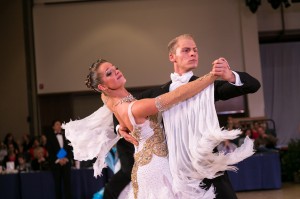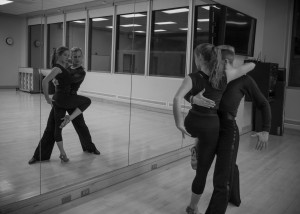
A BYU ballroom dance member effortlessly whirls his dance partner across the floor at the championship ballroom dance competition in the Marriott Center. He finishes the dance with one last turn, releasing his partner’s hand and taking a final bow to the crowd.
Casey Treu, an Orem native who began dancing at 7, admits ballroom dancing has never come easily to him because dancing is more mental than physical. Learning new ballroom dancing steps is challenging because he has dyslexia.
“I was able to win a couple of national titles in ballroom,” Treu said. “Dancing hasn’t necessarily come easy to me; I’ve still had to work hard at it. Being dyslexic, I process information slower and different — but I can.”
For many Americans like Treu, being properly understood as dyslexic presents a challenge. Dyslexia awareness is beginning to increase across the nation, but people still lack proper training and acknowledgement of this learning disability.

Dyslexia is a condition someone may inherit that makes it difficult to read, write and spell, despite average intelligence, according to Bright Solutions for Dyslexia.
A common myth is that dyslexia is rare, but the disability affects 20 percent of the population in the U.S.
Susan Barton is a national dyslexia expert who founded Bright Solutions for Dyslexia and travels the country educating others. “Most people who know nothing about dyslexia still think it’s those poor kids who see things backwards,” Barton said. “If I had a dime for every time somebody said that to me.”
Dyslexia is not a vision problem, so people with it don’t see words backwards; they see them the way any person would. Those with dyslexia can read up to a point but will eventually hit a wall because the words become too complex and they must sound out unknown words, according to Bright Solutions for Dyslexia.
“They will all hit the wall by third grade in reading development,” Barton said. “Because the letters don’t make sense to you, so you’re trying to guess based on shape, guess based on pictures, guess using your intelligence on what words make sense at that thought in the sentence.”
Those with dyslexia sometimes guess every word they can think of that might start with a beginning letter. That doesn’t work for very long, Barton said.

“I don’t think we are going to make much of a dent until teachers are trained about this in their teacher training colleges,” Barton said. “All teachers, not just reading specialists, or at least all elementary school teachers. Because once they know what it looks like and what it is, they won’t be able to ignore it.”
Grassroots groups such as Decoding Dyslexia are starting to take action so education can be provided. Decoding Dyslexia involves 47 states, and its motto is “Educate, Advocate, and Legislate.” Each state has a website, with resources on what people can do to get involved such as Decoding Dyslexia Utah.
Leora Smith Appleby, a mother of twins with dyslexia, from Fayetteville, Pennsylvania, is part of Decoding Dyslexia Pennsylvania.
“We aren’t experts or anything,” Appleby said. “It’s just parents who have children with dyslexia, and we want to offer other parents support, our collective experiences, help encourage them to meet with local policy makers and tell the stories of their children to try and get policies and legislation changed.”
Mary Ellen Moore, a language arts interventions specialist at Pennsylvania Virtual Charter School, said dyslexic brains don’t have the same pathway to read that a person who doesn’t have dyslexia does, but the brain can be retrained.
“I feel like every day, every word, every path that they take, I am helping them to rewire that brain, and it’s like — a miracle,” Moore said. “Their brain can change. Even though it’s not naturally that way, it can become that way.”
Moore began teaching in American Fork after her graduation from BYU and wishes she knew then what she knows now about dyslexia.
“I look back now and know that the students in my lowest reading groups who struggled with their weekly spelling tests and yet could discuss science and history topics in the class with ease were dyslexic,” Moore said.
Heather Brandt, an elementary school teacher in Pennsylvania, said teaching kids with dyslexia is tough but fulfilling.
“It’s so rewarding, because most of them want to read so badly, and when they finally get taught on their level and don’t have to guess they get so excited,” Brandt said. “The older kids don’t show it, but the little kids get so excited. I’ll usually say, ‘We have a reader in the house,’ and they realize for the first time that they can read, and they don’t say, ‘Oh my gosh, I can read,’ but it’s written all over their face.”
Despite having this learning disability, many people with dyslexia are talented in other aspects of their life. Treu is one of those people. Being successful in dance is what gave him confidence growing up. Watching him dance effortlessly across the ballroom floor, one would never know that learning the steps is challenging for him.
“When I learn a new, real technical skill, it takes me time to learn how to do it well,” Treu said. “I mix up steps, I mix up concepts, I mix up musical ways to count. But I’m mostly grateful for no grammar to be involved with my dancing.”




